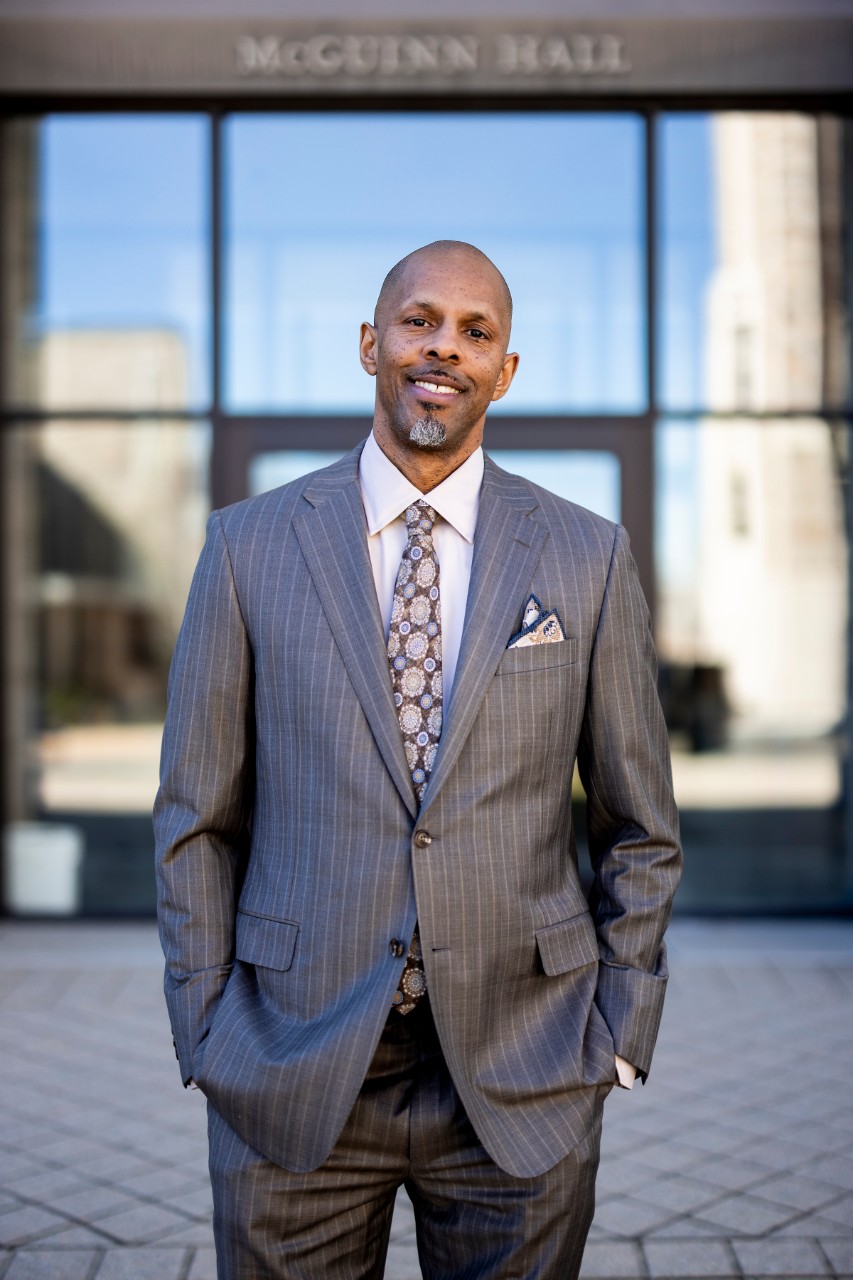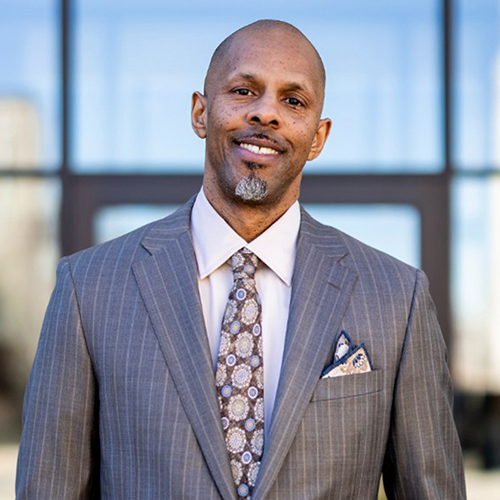
Roberty O. Motley, Jr. Photo by Caitlin Cunningham, BC photography.
A few years ago, a pair of researchers at the Boston College School of Social Work received a two-year, $395,000 grant from the Robert Wood Johnson Foundation, a philanthropic organization focused solely on health.
Robert O. Motley Jr. and Christopher Salas-Wright used the funding to study how rates of exposure to police violence that is perceived to be motivated by racism varies across the gender, ethnicity, and birthplace of young Black and Latinx people living in the United States.
Their study, which included interviewing and surveying more than 1,000 Black and Latinx people aged 18 to 29, is now finished. But their experience has highlighted the advantages of collaborating with non-federal sponsors to conduct meaningful studies with far-reaching consequences.
“I really enjoyed my experience working with the Robert Wood Johnson Foundation,” said Motley, an assistant professor who studies the interplay between racism, violence, and trauma as director of BCSSW’s Racism-based Violence Injury and Prevention Lab. “I feel like the people I worked with really cared about who they’re giving money to, and they’re going to invest in you to ensure that you produce a product that can be helpful. They want to make sure that people know about it, that it’s impactful, and that it’s being disseminated wisely.”
We asked Motley to reflect on his collaboration with the Robert Wood Johnson Foundation, with a particular focus on how he connected with the organization, what the grant application process was like, and why he’d do it all over again if he had the chance.
First of all, what did your research project focus on?
Fellow BCSSW Professor Christopher Salas-Wright and I were looking to develop a measure to capture the different types of ways that people can be exposed to police violence, particularly violence that people perceive to be based on racism. The project itself builds on a previously funded project that I did for my dissertation, when I surveyed more than 300 Black college students in St. Louis who had experienced police violence, witnessed police violence in person, or watched video of police violence in the media. What I found is that the mental health of young Black people plummets when they are exposed to racism-based police violence.
This time around, we wanted to duplicate that study with a much larger and much more diverse ethnic sample. We had conversations with Lisa Nowak, senior associate director of corporate & foundation relations at BC, and Linda DeLauri, director of research and program development at BCSSW, who helped us identify non-federal sponsors, and we ended up submitting our proposal to the Robert Wood Johnson Foundation’s Evidence for Action Program. The program had put out a call for submissions specifically aligned with validating a measure focused on racial equity, and I later found out that our project was the first study that the Evidence for Action Program had funded.
How long was the study and how much money did you receive for it?
We received a two-year, $395,000 grant to interview and survey a total of more than 1,000 Black and Latinx people aged 18 to 29, asking how often they have experienced police violence, witnessed police violence in person, and watched video of police violence in the media.
Can you describe the application process?
It was pretty similar to the length of a grant application for the National Institutes of Health. But before we could submit the formal application, we had to submit a budget, a dissemination plan, and a letter of intent. The letter of intent, which I had never written before, was something like two pages long, and we had to lay out the aims of the study and the methods for each aim.
We submitted the letter of intent in November of 2021. The Robert Wood Johnson Foundation accepted it in March of 2022 and then asked for our full proposal. We submitted our full proposal that same month and received some very pointed feedback in early April. The foundation wanted us to do two things: narrow the scope of our study to specifically examine the impact of racism-based police violence on young Black and Latinx adults and translate our findings into Spanish. So we took their feedback, addressed it, sent our proposal back less than a month later, and got it accepted.
What happened next?
We first had to recruit a panel of three content experts—individuals who work on racism discrimination and its impact on different ethnic minority populations—to vet the items that we wanted to include in our survey. We also had to create a community advisory board of emerging adults, both Black and Latinx, to also provide us feedback on our survey.
What was your relationship like with your project officer? How much say did they have in your application? How often did they give you feedback?
We weren’t assigned a project officer until after we submitted our letter of intent. Once the foundation accepted the LOI, a woman named Erin Hagan, deputy director of the Evidence for Action program, was assigned to be our program official.
We met her via Zoom because she’s based in Hawaii and that’s when she answered our questions about the process. What was interesting is that she herself is an expert in psychometrics, so that was a good fit for us.
After we received feedback on our LOI, we met with Erin again. This time, we talked about getting our costs down under $400,000, narrowing our study down to young Black and Latinx adults, and translating our findings from English to Spanish. Those were the three big things that we needed to change in our application. We did that and a few weeks later, we had our grant.
How much of a role did your community partners play in this process?
Our community partners played a vital role in the project. After we received funding, we met with our community partners via Zoom a few times. Following those meetings, we created recruitment flyers in collaboration with our partners, who helped us disseminate the flyers to individuals we wanted to participate in cognitive interviews.
What was the most enjoyable part of the process of preparing the grant for the Robert Wood Johnson Foundation?
The most rewarding part of the process was putting the letter of intent together and getting the email from the foundation saying that it wanted a full proposal. This was a new process for me and I initially didn’t see the significance of the LOI. But once we had our initial conversation with Erin and she told us that, once an LOI gets accepted, you have a more than 40 percent chance of getting funded, I was like “Wow, we really have a shot of getting this thing.”
What was the most challenging part of the process?
The most challenging part was working with our community partners to recruit folks to participate in the study simply because we had so many partners. In particular, we were working with community advisory board members and figuring out scheduling with the content experts who were spread out across the country. We had partners in Orlando and Miami and Boston, and I didn't know these individuals, but rather had to build relationships with them via Zoom.
We did have five or six graduate research assistants working with us from the start. That helped a lot. I had one doctoral student and two master’s students working with me in my lab and then we had a few other doctoral students from the Lynch School of Education and Human Development who assisted with the study as well.
What’s the status of the study now?
Our first manuscript—our validation paper—was published earlier this month in the Journal of the Society for Social Work and Research. We’re also working on three or four other papers that we’re preparing to submit, but we wanted to wait for our first paper to be accepted so we could cite it in subsequent publications.
We’re also getting ready to share our findings as part of a presentation to all of the other Robert Wood Johnson Foundation awardees. That’s coming up this summer, and it’s something the foundation does every year.
Have you met the other award winners before?
Last year, the foundation held a conference for the award-winners in St. Louis and I attended that. The foundation also does check-ins with its grant recipients, and I’ve met with representatives of the organizations between 15 and 20 times over the past two years.
The foundation is very involved in the process and, once you’re getting ready to start disseminating your information, you can send them your manuscript to solicit edits before you submit it.
Even when my study is over, I still can send them manuscripts to look over. The foundation is really vested in your success and in the process, really on top of things and wanting to make sure that you’re successful.
What did you learn about working with non-federal sponsors as a result of this process?
I really enjoyed my experience working with the Robert Wood Johnson Foundation. I feel like the people I worked with really cared about who they’re giving money to, and they’re going to invest in you to make sure that you produce a product that can be helpful. They want to make sure that people know about it, that it’s impactful, and that it’s being disseminated wisely.
Is there anything else you would like to add?
If I had to do it all over again, I wouldn’t do anything differently. I think it was a good learning experience, and I think all scholars and researchers should seek out opportunities from non-federal sponsors.




